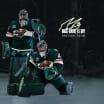This story is part of Wild.com's 2017-18 season preview.
ST. PAUL -- The Xcel Energy Center has been home to the Minnesota Wild for 17 years. Travis Larson, ice operations manager and event manager, has been here every step of the way -- and then some.
Larson's ties to Minnesota hockey date back through the North Stars' tenure at the Met Center, where he took a part-time job in 1990. Since then, both the game of hockey and the accepted standards for NHL-grade ice rinks have changed drastically.
Meet Travis Larson, the Minnesota Wild's ice man
Ice operations manager has been with franchise since the beginning

By
Kayleigh Jackson / Wild.com
Larson's primary concern is making sure the ice is in good shape and is safe for everyone on and around it, he says. The ice surface, boards, benches and glass all fall under his domain. If a board is warped or a glass panel breaks, Larson and his crew of 14 are ready to fix it.
While Larson has made an impact around Xcel Energy Center, he didn't set out with the intention to become an ice operations and event manager. "I didn't know what to do with my life back then, a long time ago," Larson said with a smile. "I also started working part-time at the Burnsville Ice Center in '92 and was just interested in refrigeration and the mechanical aspects of it. And I stumbled across a class for arena and recreational facility management."
While still taking classes, Larson began managing Dakota Sport and Fitness in Prior Lake in 1994. When the Wild came to town and preparations began on Xcel Energy Center six years later, it was a no-brainer for Larson to move back to professional hockey.
"I had so much fun at the Met I thought it would be fun to get back into this stuff again, and then I actually ended up being the original ice guy."
While Larson doesn't work directly with the arena's conversion crew, his work hinges on their ability to quickly turn the ice surface into a concert floor -- and back again -- in a process that usually takes about six hours.
To prepare for a concert, the conversion crew puts insulation panels over the ice and takes down the glass and safety netting. They then take remove some of the boards where the stage will go, but leave the rest as a means of separating floor seats from other areas of the crowd.
When a show ends, they'll do it again -- in reverse this time.
Because putting the ice in is so time-consuming and relies on very precise factors, it's not plausible to fully remove the ice every time another event occupies Xcel Energy Center. When the ice is built from scratch, the procedure takes hours, if not days.
First, the concrete floor must be cooled down to 16 degrees Fahrenheit so the ice will adhere to it.
Then, a skim coat of water goes down, which will be painted with white biodegradable paint once it freezes. To seal in the paint layer, the rink will get more coats of water before the lines and logos are painted on.
Once that's done, Zamboni drivers take a few more laps to seal it again before flooding the rink to a safe, playable depth of an inch and a quarter.
Larson said it's important to try and avoid humidity when working with ice, and Minnesota is usually quite conducive to that. There's a sweet spot of timing for when the best ice sheet can go in.
"Spring and fall isn't the greatest but we do what we can do to overcome those challenges," Larson said. "You're kind of part weatherman, kind of part mechanic, a part everything."
With the team's new "This Is Our Ice" campaign, fans are allowed to contribute their own water to the ice surface. Larson said that this water, once filtered, goes right onto the ice as soon as the next Zamboni goes out.
Larson will also oversee the Wild's new practice facility, the TRIA Rink at Treasure Island Center, when it opens in a few months. He worked with the design engineers to ensure that the fifth-floor rink will be able to maintain high-quality ice and safe standards.
After 17 years, Larson knows the course of the season well, even if the actual dates of events and games change. Larson said the ice will usually go in in late August or early September, and isn't removed until after the end of the Wild's season, whenever that may be.
When that melancholic time of year rolls around, the concrete base gets heated up to detach the layers of ice on top of it before the ice gets plowed off, melted and allowed to drain. Because the water has been filtered and all the paint is biodegradable, the runoff can go right into sewers with no adverse affects on the environment.
Though most of his work goes on behind the scenes, Larson is an integral part of the Wild's success. It's well known around the NHL which arenas have questionable ice or springy boards, but Xcel Energy Center rarely comes up in that conversation.
"Talking to my peers from other buildings that come through, they're like 'boy, oh boy, you got it lucky here,'" Larson said. "Making ice here is actually pretty easy."


















